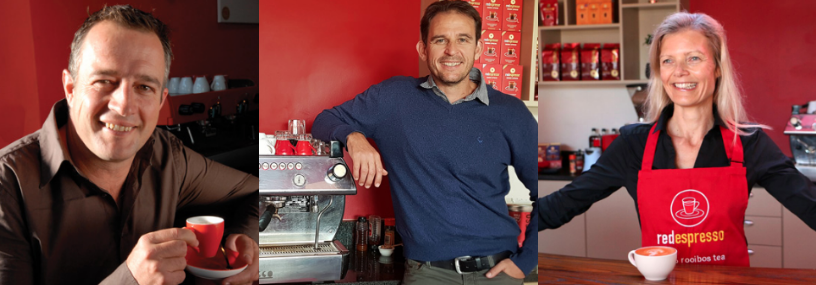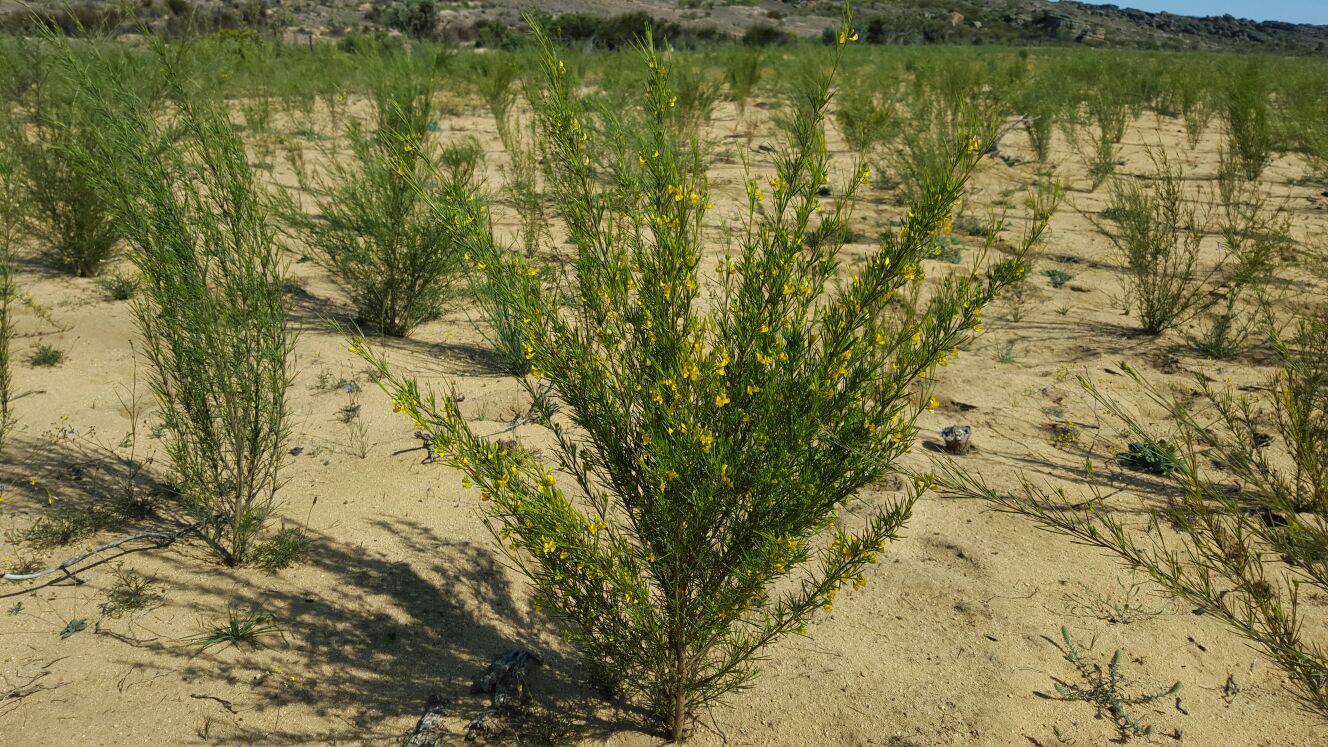If you haven't heard of Red Espresso, then where have you been? The Red Cappuccino is a firm favourite on South African cafe menus. So you may know the brand but do you know about the raw product, the famous rooibos tea that is so proudly South African. We chatted to Pete and Monique Ethelston about the farmers behind this precious crop and what goes into getting the final product.

Carl, Pete and Monique: The Brains Trust behind Red Espresso
Tell us a little about where rooibos tea grows?
Rooibos tea is a waist-high shrub with tiny yellow flowers that is classed as fynbos and part of the Cape Floral Kingdom. It grows in the Cederberg Mountains about four hours north of Cape Town…and nowhere else in the world! The Cederberg is a rugged and remote spot with incredible hiking and climbing and a whole bunch of San rock art. In fact, the San were the first to discover the delicious, healing tea made from the rooibos plant. It gets its name (meaning “red bush” in English) from the fact that its fine, needle-like green leaves turn a rich red colour once cut and allowed to dry in the sun.
What is so special about this indigenous South African plant that we all love!
Most South Africans have grown up on rooibos and know that it is caffeine-free and good to drink before bed or when you’re feeling unwell. But there’s more to it than that. In recent decades it has become increasingly popular all over the world…thanks to its naturally sweet taste and the fact that it’s loaded with antioxidants that help combat stress, allergies and insomnia and also fight the ‘free radicals’ that can cause premature ageing, heart disease and cancer.
Red Espresso – with its patented grind and espresso method of preparation, just like coffee – contains 10 times more antioxidants than regular rooibos!!

What kind of growing conditions are optimal for rooibos?
Rooibos is a tough, hardy plant that is born to live in the rocky soils and harsh climate (temperatures hit 50ËšC in summer and drop well below zero in winter!) of the Cederberg region. The clever little plant makes up for lack of rainfall with a three-metre long taproot that seeks out ground water.
Is there a specific kind of science, a "rooibos agronomy" that has developed over the years in maximising the flavour, the output or the quality of the tea?
Not all rooibos is created equal. Much like coffee (and wine grapes for that matter), rooibos which grows at high-altitude and in especially harsh, low-rainfall corners of the Cederberg produces stronger-tasting tea. At Red Espresso we only use high-altitude rooibos. The remote location of our tea lands makes mechanisation impossible, so our tea is grown wild, with no pesticides and irrigation. The biggest threat to our tea lands comes from baboons, porcupines and klipspringers!
Leaving fynbos corridors between our tea lands doesn’t just give us the highest biodiversity scores in the industry, it also assists pollination. Away from the farms, the special science that we’ve developed to maximize Red Espresso’s flavour and health benefits lies in the patented grind that has been painstakingly perfected over 13 years to provide optimal espresso extraction and consistent quality on all coffee appliances. Rooibos is so tough that we have to replace our blades every ton!
What are some of the challenges facing tea growers in our country? Is there anything that we, as tea and coffee professionals and consumers can do to help?
Like most of the Cape, the Cederberg has been hit hard by the drought – for the past four years, rooibos tea harvests have been a lot lower than normal…Especially on smaller farms at higher altitudes.
Another challenge facing the industry is that most rooibos tea is sold in bulk which leaves the farmers at the mercy of the industry price: when there is an oversupply their price drops substantially.
We buck the trend by working directly with our farmers and adding all value to our products in South Africa. This means we are able to offer our farmers price consistency…a massive boost in a very unpredictable industry.
What you can do to help, is to be more conscious of the rooibos tea brands that you support and demand to know the full journey of their tea from crop to cup. Change needs to be driven by consumers buying tea that is produced according to Fairtrade principles. This will go a long way towards fixing some of the problems in the industry.
Rooibos is the key ingredient in Red Espresso. Tell us about your relationship to the tea farmers…Do you have any special anecdotes?
Red Espresso has been dealing with the same single-estate, third generation farmers since we launched in 2005. We offer them price consistency and in return they give us unwavering quality. What started off as a business relationship has blossomed into a real, heartfelt friendship: most of our business meetings involve lambchops and Pinotage! We’ve watched as the farmer’s sons have become more and more involved in the business…And they’ve looked on as our daughters have grown from babies into teenagers.
Four years ago, we started working with previously-unemployed farmers in Wuppertal – home to some of the best rooibos growing conditions on the planet. We’ve given these subsistence farmers seed, loaned them equipment and shared our farming and business knowledge with them. Already we’ve changed their lives (they’re earning 10 times more than they ever have) and more and more farmers are coming on board every year. It isn’t just great for them (one of our subsistence farmers recently replaced his donkey cart with a Hilux!) it’s also helped us to secure a new, sustainable source of top notch tea.

What insights can you give our readers after all these years of working so closely with the farmers ?
We’re lucky to have really got to know a corner of South Africa that very few people experience. Leopards roam wild, there’s no hospital or corner café and no cell phone reception...Power outages can last for days (maybe not so unusual in South Africa anymore!) and flash-floods and snowstorms can cut the valley off entirely.
The farmers, who grow tea in the same way their forefathers have done for centuries, are a different breed. They’re hardworking, resourceful (’n boer maak ’n plan!) and we’ve learnt that our honour and our handshakes mean far more to them than a piece of paper ever could.
What are the factors consumers should be aware of when they choose their tea products? Do things like sustainability, ethical sourcing, fair / direct trade pricing for growers exist in the tea industry?
The coffee industry is more developed than the rooibos tea industry when it comes to understanding the full journey a product takes from crop to cup. Most rooibos tea brands are not transparent about traceability from crop to cup and their quality can vary greatly. Blending tea from different estates and bulking it up with substandard product is common practice. There also is no industry grading for rooibos tea that consumers can use as an indicator of quality.
At Red Espresso, we follow the principles of sustainability, ethical-sourcing and Fairtrade pricing and pride ourselves on full traceability from crop to cup. All our tea comes from single estates and is never blended. We’re working hard to change the rooibos industry for the better and to make a real difference to the lives of the farmers and farmworkers we work with. Being pioneers/innovators isn’t easy, but we’re passionate about helping to bring about the change that is so sorely needed.